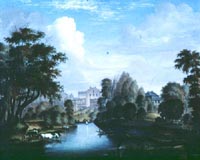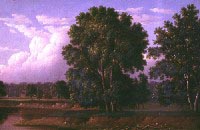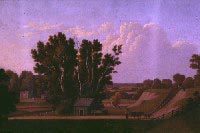
 |
Roger Smith's Mill, London (1848-49), oil on paper, 25.1 x 38.1 cm., Anonymous gift, 1964
|
 |
The Forks of the Thames (n.d.), oil on canvas, 61 x 71.1 cm., Art Fund, 1948
|
 |
The Flats, London (1850), oil on paper, 24.2 x 36.8 cm., Art Fund, 1948
|
 |
The Clay Banks, London (c. 1860), oil on paper, 24.2 x 35.6 cm., Art Fund, 1948
|
James Hamilton (1810-1896) was born in Cornwall, England and died in London, Ontario. Little is known about his early art training. However, it is significant that his great uncle, Gustavus Hamilton, was a well-known Irish miniaturist and his father was a military officer. His painting style is similar to both the miniature style and the military topography taught during that period. The family came to Canada in his youth. Hamilton operated a private school in York (now Toronto) and was involved in the local art scene. His work was exhibited in the first art show in that city and work was compared favourably with that of another local artist, Paul Kane. He first appeared in London in the early 1840s as the manager of the local branch of the Bank of Upper Canada and was an active participant in the local art community.. He always regarded himself as "a gentleman amateur" and his painting was exhibited at fairs and similar art events in the amateur category. Hamilton executed genre and landscape scenes in a picturesque documentary style using oil and watercolour.

|
|